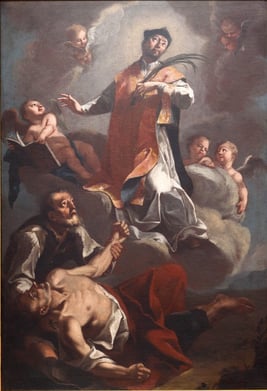'You would know our Lord's meaning in this thing? Know it well. Love was His meaning. Who showed it to you? Love. What did He show you? Love. Why did He show it? For love. Hold on to this and you will know and understand love more and more.'" —Julian of Norwich
For weeks now, paper hearts and heart garlands have decorated storefronts and bulletin boards. Like many holidays with religious origins, its significance has been lost in a secular culture. Many Catholics may wonder if there actually was such a saint as Valentine. Although the origin of the “holiday” and the identity of St. Valentine is shrouded in the mists of time, it is not completely hidden.
This is what we know.
According to the Nuremberg Chronicle, St. Valentine was a priest, perhaps a bishop, who was martyred around the year 269. The details of his life are limited, but he was a real person: both a Roman catacomb and an ancient church are dedicated to him. Also, in A.D. 496, Pope Gelasius declared February 14th as a day to remember his martyrdom.
 The Triumph of Saint Valentine by Valentin Metzinger / Public domain, via Wikimedia Commons
The Triumph of Saint Valentine by Valentin Metzinger / Public domain, via Wikimedia Commons
Under the reign of Claudius the Cruel, men were failing to join the military in sufficient numbers. The emperor believed that men were too attached to their wives and families, so he banned all marriages. St. Valentine defied this order and continued to perform marriages in secret. Valentine was arrested and condemned to death on February 14th.
The practice of sending Valentine’s Day cards is related to a story from his hagiography. One version of the story relates that Valentine healed the blind daughter of his jailer. Before he was martyred, he left her a note and signed it “Your Valentine.” According to some historians, the further association of Valentine’s Day with romantic love probably originated during the Middle Ages, the age of “courtly love.”
St. Valentine, Love, and The Heart
Even if the historical St. Valentine has little to do with the popularity of the current holiday, the desire to give and receive love is a fundamental aspect of the human person. As Viktor Frankl, psychologist and concentration camp survivor, observed:
I saw the truth. . . that love is the ultimate and the highest goal to which man can aspire. Then I grasped the meaning of the greatest secret that human poetry and human thought and belief have to impart: The salvation of man is through love and in love. — Victor Fankl, Man’s Search For Meaning.
There is deep spiritual significance to the meaning of “heart” in Scripture. Depending on the translation, ‘heart’ appears from 500 to over 800 times. It does not, however, refer to the physical organ. According to the Denver Biblical School: “In Scripture, "heart" (Heb: lev/levav) refers to the seat and the origin of all human thought, motivation, will and action–in other words, the core of the whole human person.”
The Catechism of the Catholic Church (2563) describes the heart as “the dwelling-place where I am” and offers an additional reflection:
The heart is our hidden center, beyond the grasp of our reason and of others; only the Spirit of God can fathom the human heart and know it fully. The heart is the place of decision, deeper than our psychic drives. It is the place of truth, where we choose life or death. It is the place of encounter, because as image of God we live in relation: it is the place of covenant.
So this Valentine’s Day, sign your cards and give your heart-shaped candy boxes and roses to your friends and loved ones with sincerity of heart, and know that truly you will be giving the gift of yourself.

